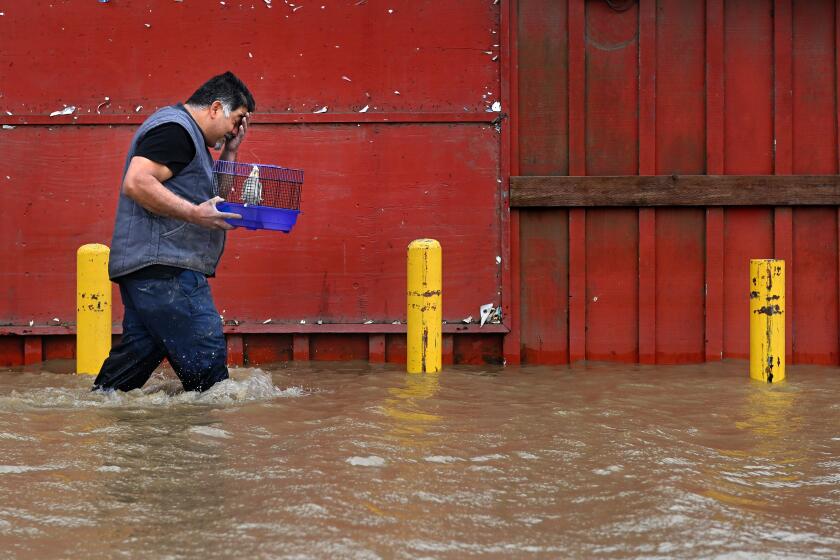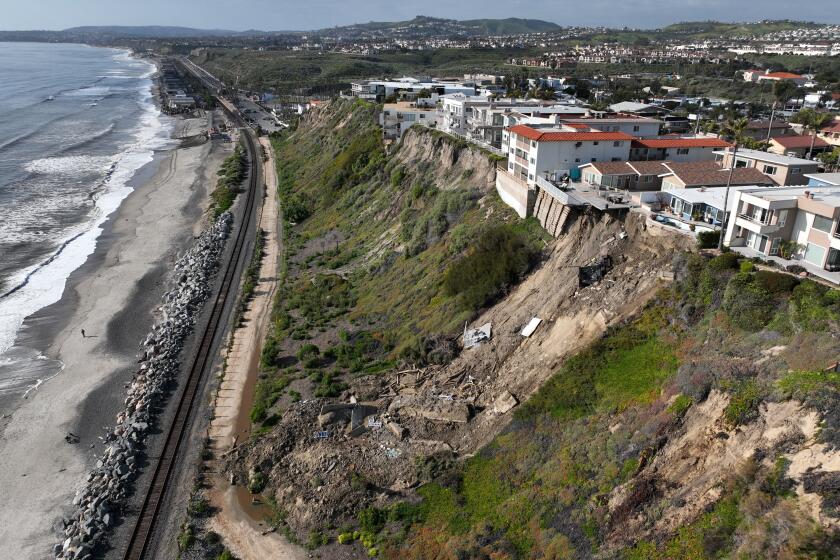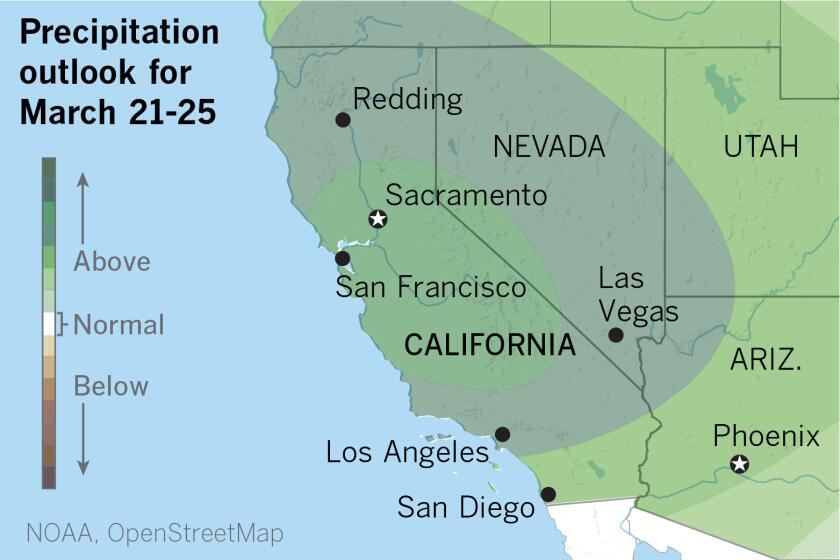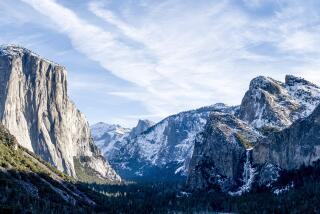Rain rapidly melts snow in mountain areas as residents face a fresh set of challenges
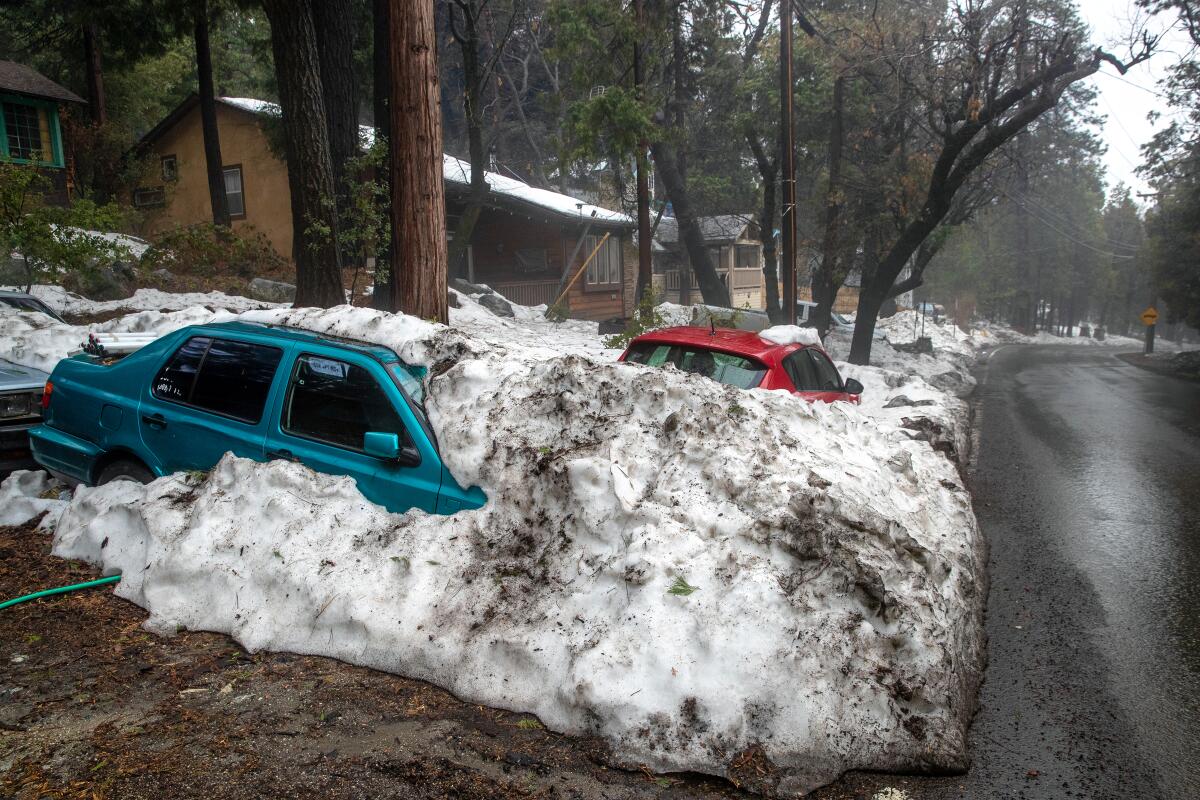
- Share via
Recent rainstorms in the San Bernardino Mountains brought both relief, melting off much of the snow that had stranded some residents for weeks, and new problems, setting off minor flooding and rockslides.
In Lake Arrowhead, Linda Knorr and her husband had been trapped inside their home for about a week and had to shovel several feet of snow off their property.
They were among many snowed in by a series of snowstorms early this month that left some mountain residents without reliable access to food, supplies and medication.
Plowing the steep highways and streets that snake through the communities of Crestline and Lake Arrowhead was painstaking work. Some residents were effectively entombed in their houses due to impassable roads or towering snow berms that blocked their driveways.
The Knorrs’ street was plowed once during the winter snowstorms, she said. Then rain from this week’s atmospheric river storm quickly melted much of what was left.
“We got several inches of rain,” said Knorr, 54. “Though more is coming next week, and maybe some snow.”
Many residents in San Bernardino County’s mountains are still far from back to normal, more than two weeks after the historic snowstorms brought unprecedented snowfall.
As much as 4.3 inches of rain had fallen on the slopes of the San Bernardino County mountains by Wednesday morning, according to the National Weather Service, and the storm had mostly cleared out by Thursday. Officials said there weren’t any major issues from the rains, despite concerns about much of the snowpack melting under the new rainfall.
San Bernardino County firefighters responded to two calls late Tuesday and early Wednesday about minor flooding at residences in Crestline and Twin Peaks, but neither required evacuation, department spokesperson Eric Sherwin said.
Rockslides hit some roadways, Sherwin said, but most of the fallen rocks were quickly cleared by crews, never completely closing roads. The largest slide was along Highway 18 near Waterman Canyon Road, he said, though all were typical for storm conditions.
Runoff slowed a bit Thursday, he said, adding that although there was still a lot of snow melting, officials were not seeing abnormal water accumulation in the mountains.
Ahead of the storms, residents were told “to prepare for flood conditions,” and county staffers worked to clear culverts and provide sandbags, county Chief Executive Leonard Hernandez said at Tuesday’s Board of Supervisors meeting.
Crews worked to ensure “150 high-priority culverts were clear,” a task complicated by the fact that “many were hidden by massive snow berms,” requiring crews to use mapping technology and old photos to find many of them, county officials said in a Wednesday storm response update.
Newsom visits inundated Pajaro, where a levee breach has displaced hundreds. Porterville residents evacuate as Lake Success overtops the Schafer Dam spillway.
Officials will continue to clear drainage paths and prepare for another storm expected to hit next week.
In Crestline, resident Aaron Creighton said there was almost a “little river running down the street” Wednesday, though much of the drainage infrastructure was updated recently and seemed to be holding up. Water was still flowing through the street Thursday, he said, but not as much.
“There’s so much melting so fast,” he said. “A few days ago I had still 5 feet of snow on my deck, and I have about 6 inches left now.”
Creighton’s first floor started to flood Wednesday and remained under about a inch of water, he said, but it took more than 24 hours for a plumber to respond because so many people were dealing with damage from the winter storms. The plumber found his flooding was caused by a pipe that burst from the cold.
“I can’t pump it out fast enough with my little Shopvac,” said Creighton, publisher and editor of Crestline’s local newspaper, the Alpine Mountaineer News. “It’s completely underwater.”
Four buildings in San Clemente have been deemed unsafe after heavy rains caused a massive landslide along the coast Wednesday, forcing many evacuations.
Downriver from the mountains, the snowmelt intensified by this week’s rain swelled waterways, turning the Santa Ana River into a dangerously fast-moving current.
At its peak Wednesday afternoon, about 11,500 cubic feet of water per second was flowing through the river. In the days before the storms, the flow rate on the river was below 1,000 cubic feet per second.
At the same time, the river’s water level peaked at nearly 6.5 feet, about 4 feet shy of the stage at which officials would have needed to take mitigation efforts, according to the National Weather Service.
The Riverside City Fire Department responded at about 10:30 a.m. Wednesday to two adults — a man and a woman — stuck on a sandbar near the Van Buren Boulevard Bridge across the Santa Ana River in Riverside, according to Battalion Chief Bruce Vanderhorst.
The Fire Department conducted a water rescued and removed the two people, who were uninjured, from the area.
Vanderhorst said the people were unhoused and they offered to connect them with their homeless solutions team but they declined and went back down to the river bottom and set up a new camp.
With most mountain roads reopened and a brief break before another atmospheric river storm — the 12th of the rainy season — is forecast to hit early next week, ski resorts and towns are preparing for an influx of visitors this weekend.
A 12th atmospheric river is possible early next week and could affect the California coast.
Knorr, the Lake Arrowhead resident, said she was surprised when Caltrans District 8 announced this week that all routes, with the exception of portions of Highway 18, were reopened to all drivers.
“When we have a tiny amount of snow, people come up and they’re not prepared — they don’t have the proper tires or vehicles or chains,” she said. “They park on the side of the highway and sled. It’s hard for our highway patrol and emergency personnel to handle the amount of people who are coming up here.”
At the Big Bear Mountain Resort, employees were readying for crowds to return to the slopes after the mountains were cut off to nonresidents for the last few weeks after the snowstorms.
“We expect visitation to tick back up to normal levels for this time of season,” resort spokesperson Justin Kanton said Thursday morning. “Looking out my window, the upper lot at Snow Summit is pretty much filled up.”
The resort was anticipating clear skies over the weekend with a small chance of showers Sunday afternoon, Kanton said.
“As far as the conditions go, it’s still amazing,” he added. “We did lose a little bit of snow due to the rain the last couple of days, but we’re still in the 75- to 100-inch range, which is phenomenal this time of season. Typically this time of year, we’re looking at the 1- to 3-feet range.”
More to Read
Sign up for Essential California
The most important California stories and recommendations in your inbox every morning.
You may occasionally receive promotional content from the Los Angeles Times.

